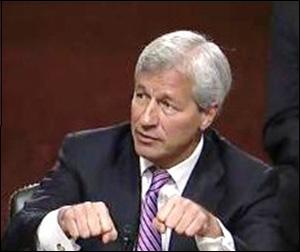By Pam Martens: January 17, 2013
Wall Street’s thoroughly discredited self-regulation that has blazed a trail of corruption across much of the securities trading landscape of America, has now given birth to a new brand of hubris – self investigation and self reporting.
Yesterday, JPMorgan released a report from its Board of Directors that found [drum roll] that the Board was not culpable in the London Whale episode, it just needed to tweak a few things going forward. London Whale refers to the blowing up of $6.2 billion of insured deposits at JPMorgan’s commercial bank through reckless trading in derivatives in London.
Likewise, a 132-page Task Force report was released which found CEO Jamie Dimon guilty of no greater sin than being too reliant on information from below. The report said: “As Chief Executive Officer, Mr. Dimon could appropriately rely upon senior managers who directly reported to him to escalate significant issues and concerns. However, he could have better tested his reliance on what he was told.”
Who was this Task Force that conducted this exhaustive study? Typically, a Wall Street firm hires an outside law firm to conduct an internal review after an episode such as this. JPMorgan hired underlings to Jamie Dimon — employees of the bank who owe their livelihoods, pensions and continued employment to the good graces of Dimon and the Board. Michael J. Cavanagh, co-head of the bank’s corporate and investment banking unit, led the Task Force study. That major media repeated the report’s finding without noting its lack of credibility is symptomatic of a Nation held hostage by power and money.
The Task Force report even noted that its facts and findings might not stack up to the facts and findings of its regulators, writing:
“This Report sets out the facts that the Task Force believes are most relevant to understanding the causes of the losses. It reflects the Task Force’s view of the facts. Others (including regulators conducting their own investigations) may have a different view of the facts, or may focus on facts not described in this Report, and may also draw different conclusions regarding the facts and issues. In addition, the Task Force notes that its mandate did not include drawing any legal conclusions, and accordingly, this Report does not purport to do so.”
The most underreported part of this story has been the fact that the $6.2 billion in losses were gambles in high risk derivatives made by the Chief Investment Office (CIO) with FDIC insured deposits held in the commercial bank. This is a key reason the FBI and Senate continue to investigate the matter, as we have previously reported.
The Task Force owned up to the reality of whose money JPMorgan was using in its report, writing:
“JPMorgan’s businesses take in more in deposits than they make in loans and, as a result, the Firm has excess cash that must be invested to meet future liquidity needs and provide a reasonable return. The primary responsibility of CIO, working with JPMorgan’s Treasury, is to manage this excess cash.”
Jamie Dimon had previously reported this fact in one of his first conference calls with analysts on the topic of the London Whale losses, but corporate media failed to focus on this aspect, despite a meltdown of Wall Street just four years prior because of reckless gambles inside institutions housing insured deposits. Trillions in taxpayer funds were needed to shore up the institutions and billions more in economic stimulus, leaving the Nation crippled with debt.
The much smaller report from the Board of Directors raised the specter that getting qualified people going forward to take the personal risk to their reputations and fortunes and hours in the day to sit on the Risk Policy Committee of JPMorgan that oversees the Chief Investment Office may be an uphill slog. The Board report said:
“In light of the increasing demands on the Risk Policy Committee and the increasing complexity of those demands, service on the Committee will probably require additional time from Committee members. The history of the Audit Committee in terms of increasing responsibility and time demands on its members likely serves as a harbinger for the Risk Policy Committee. The Chairman of the Committee will necessarily take the lead and commit the most time, but the other members of the Committee should be prepared to shoulder some of the responsibilities in order to mitigate the burdens on the Chairman.”


